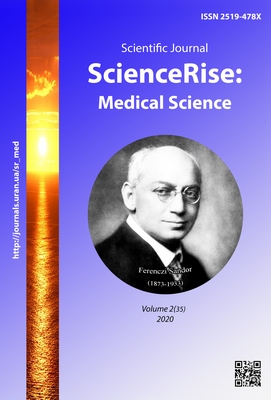Clinical and laboratory portraits of patients with tuberculosis and alcohol consumption
DOI:
https://doi.org/10.15587/2519-4798.2020.199602Keywords:
tuberculosis, alcohol, consumption, abuse, quality of life, clinical data, laboratory dataAbstract
The aim was to study the clinical and laboratory data of patients with firstly diagnosed pulmonary tuberculosis with different levels of alcohol consumption.
Materials and methods. The study included 102 patients with firstly diagnosed pulmonary tuberculosis and preserved sensitivity to anti-TB drugs with alcohol consume. The activity of gamma-glutamyltranspeptidase was determined by the kinetic method. C-reactive protein levels were determined by latex agglutination. To analyse the parameters of the quality of life the SF-36 questionnaire was used. Assessment of the alcohol consumption level was carried out using the Alcohol Use Disorders Identification Test. The obtained data were processed using the Statistica software.
The results. According to the results of the AUDIT questionnaire, patients were divided into three groups. Group 1 – persons who scored 0–7 points, group 2 – 8–15 points, group 3 – 16 points or more. The quality of life in the first two groups were at a fairly high level with a predominance of the physical component of health. In the third group, the average indicators for both components were significantly lower than the first two groups. Group 3 patients were more socially maladaptive. In the group of alcohol-abusing patients, pathological process predominant affecting more than one lobe of the lungs with signs of destructive processes of the lung tissue. In 82.1 % of patients in group 3 mycobacterium tuberculosis was detected in sputum already at the stage of microscopic examination. In tuberculosis patients with increasing of alcohol consumption, there was an increase the blood levels of leukocytes, CRP and ESR, manifestations of anemia and a decrease in the activity of cellular immunity due to a decrease of lymphocytes degree. Maximum disturbances occurred in group 3. Indicators of the functional state of the liver, except for ALT, in group 3 were significantly higher than in group 1.
Conclusions. Patients with tuberculosis who consume alcohol, has a decrease in social adaptation, quality of life, the more clearly intoxication syndrome, the prevalence of spreading forms of tuberculosis with massive bacterial excretion, as well as impaired liver function
References
- Global tuberculosis report 2019 (2019). Geneva: World Health Organization; Licence: CC BY-NC-SA 3.0 IGO.
- Simou, E., Britton, J., Leonardi-Bee, J. (2018). Alcohol consumption and risk of tuberculosis: a systematic review and meta-analysis. The International Journal of Tuberculosis and Lung Disease, 22 (11), 1277–1285. doi: http://doi.org/10.5588/ijtld.18.0092
- Silva, D. R., Muñoz-Torrico, M., Duarte, R., Galvão, T., Bonini, E. H., Arbex, F. F. et. al. (2018). Risk factors for tuberculosis: diabetes, smoking, alcohol use, and the use of other drugs. Jornal Brasileiro de Pneumologia, 44 (2), 145–152. doi: http://doi.org/10.1590/s1806-37562017000000443
- Pasala, S., Barr, T., Messaoudi, I. (2015). Impact of Alcohol Abuse on the Adaptive Immune System. Alcohol research: current reviews, 37 (2), 185–197.
- Francisco, J., Oliveira, O., Felgueiras, Ó., Gaio, A. R., Duarte, R. (2016). How much is too much alcohol in tuberculosis? European Respiratory Journal, 49 (1), 1601468. doi: http://doi.org/10.1183/13993003.01468-2016
- Barr, T., Helms, C., Grant, K., Messaoudi, I. (2016). Opposing effects of alcohol on the immune system. Progress in Neuro-Psychopharmacology and Biological Psychiatry, 65, 242–251. doi: http://doi.org/10.1016/j.pnpbp.2015.09.001
- Laprawat, S., Peltzer, K., Pansila, W., Tansakul, C. (2017). Alcohol use disorder and tuberculosis treatment: A longitudinal mixed method study in Thailand. South African Journal of Psychiatry, 23. doi: http://doi.org/10.4102/sajpsychiatry.v23i0.1074
- Melnyk, V. M., Turchenko, L. V. (2016). Tuberkuloz i alkoholna zalezhnist – aktualna problema sohodennia. Ukrainskyi pulmonolohichnyi zhurnal, 4, 9–18.
- Pro zatverdzhennia Zmin do Standartu nadannia medychnoi dopomohy khvorym na khimiorezystentnyi tuberkuloz (2012). Nakaz MOZ Ukrainy No. 1045. 12.12.2012. Available at: https://zakononline.com.ua/documents/show/3369___3369
- Ware, J. E., Sherbourne, C. D. (1992). The MOS 36-ltem Short-Form Health Survey (SF-36). Medical Care, 30 (6), 473–483. doi: http://doi.org/10.1097/00005650-199206000-00002
- Babor, T. (2001). Audit, the alcohol use disorders identification test: guidelines for use in primary care. Geneva: World Health Organization.
Downloads
Published
How to Cite
Issue
Section
License
Copyright (c) 2020 Ivan Hrek, Maryna Kochuieva, Olena Klimova, Anton Rohozhyn, Vasyl Kushnir

This work is licensed under a Creative Commons Attribution 4.0 International License.
Our journal abides by the Creative Commons CC BY copyright rights and permissions for open access journals.
Authors, who are published in this journal, agree to the following conditions:
1. The authors reserve the right to authorship of the work and pass the first publication right of this work to the journal under the terms of a Creative Commons CC BY, which allows others to freely distribute the published research with the obligatory reference to the authors of the original work and the first publication of the work in this journal.
2. The authors have the right to conclude separate supplement agreements that relate to non-exclusive work distribution in the form in which it has been published by the journal (for example, to upload the work to the online storage of the journal or publish it as part of a monograph), provided that the reference to the first publication of the work in this journal is included.









